Coty
Continue to: Coty (post-1940)
François Coty was born Joseph Marie François Spoturno in Ajaccio, Corsica in 1874. His mother, Marie-Adolphine-Françoise Coti [1852-1877], died when he was only three and his father disappeared a few years later in unknown circumstances, so the boy was largely raised by his great-grand mother, Marie-Josephe Spoturno. When Marie-Josephe died in 1887, François was moved to Marseilles to live with his grandmother, Anna Maria Belone Spoturno. What he did while in her care is unclear but de Sarrhan suggests that he was selling lace and other fancy goods around the streets of Marseilles rather than going to school (de Sarran, 1990, p. 8).
Between 1893 and 1898, François underwent military service, after which he moved to Paris to work as an unpaid assistant for Emmanuel Arène, a senator for Corsica. In 1900, François met and married Yvonne Alexandrine Le Baron [1882-1965]. It was also around this time that he was introduced to Raymond Goëry who owned a pharmacy on the Avenue de la Motte-Piquet. It appears to have been Goëry who triggered François’ interest in creating perfumes.
In 1902, François opened a business at 28 Place Vendôme to sell Le Bouquet Idéal along with a range of Essences Très Concentrées, Sachets and Coffrets-Sultanas. François opened the business using the name Coty – a modification of his mother’s family name – rather than Spoturno, and he would continue to do so from here on.

Above: 1902 Coty Le Bouquet Idéal.
Unfortunately, sales were poor and this appears to have been the reason why Coty travelled to Grasse in 1903 to spend time at the Chiris perfume factory and research facilities (Toledano & Coty, 2009, p. 56). There he got a better understanding of the process of perfume formulation and manufacture.
Returning to Paris at the end of 1903, Coty had his first real success with a new perfume, La Rose Jacqueminot, developed with two synthetics he had come across while at Grasse and rose essence he had bought cheaply from a bankrupt essential oil business near to the Chiris factory. The perfume went on sale at the Les Grands Magasins du Louvre department store in 1903-4. According to legend, almost certainly untrue, Coty secured this first order for La Rose Jacqueminot after smashing a bottle of it on the floor of the store to generate interest from customers.
Where Coty got the money to fund all of these ventures is something of a mystery but financial support may have came from a variety of sources including: the Chiris family; François Carnot [1872-1960] related through marriage to the Chiris family; the Dubois Le Baron family; and Coty’s grandmother, Anna Marie Belone Spoturno (Toledano & Coty, 2009, p. 63).
Although credit must be given to Coty for formulating La Rose Jacqueminot, L’Origan (1905) and the numerous perfumes that followed, and to his wife, Yvonne Alexandrine Le Baron, for her part in helping to establish the business, Coty’s good fortune was due in part to an alignment of scientific and economic developments.
On the supply side, the use of volatile solvents to extract usable oils, flavours and fragrances – a technique pioneered by the Chiris family – and the replacement of many natural odours with synthetics had reduced the cost of making perfumes and made it easier to manufacture them in bulk. On the demand side, the introduction and growth of the department store – a trend that began in Paris – had made many luxury goods, such as perfumes and jewellery, available to the growing middle class.
Coty described himself as a ‘Parfumerie de Luxe’ but his perfumes were aimed at the middle classes, the first perfumier to do so, and he ushered in a number of innovations to help make his perfumes successful in this market. He made smaller bottles so that he could sell perfumes at lower prices and he bottled and packaged his perfumes in beautifully designed containers to give his mass-produced perfumes an aura of luxury.
Coty’s democratisation of perfume was not without its detractors in France. In 1890, Aimé Guerlain and Charles Gallet had organised an association of perfume manufacturers, Le Syndicat National de la Parfumerie Française, which was joined by prestigious perfume houses such as L.T. Piver, Guerlain, and Houbigant. Coty was consistently refused membership (Jones, 2010, p. 33).
Others traded on his success by counterfeiting or copying Coty perfumes.
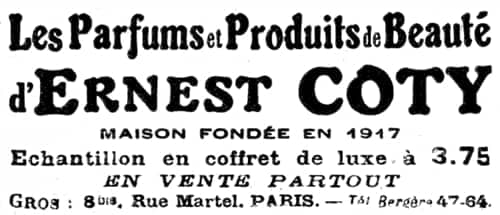
Above: 1919 Parfums et Produits de Beauté d’Ernest Coty. Established in 1917, the company copied Coty fragrances and packaging until François Coty took them to court.
Coty S.A.
In 1905, François founded Coty S.A. (Société Anonyme) in Paris and the following year he established a new retail outlet at 23 Place Vendôme not far from René Lalique at number 24. Lalique would soon be developing coordinated packaging designs – bottles, labels and boxes – for Coty perfumes and for some Coty cosmetics.
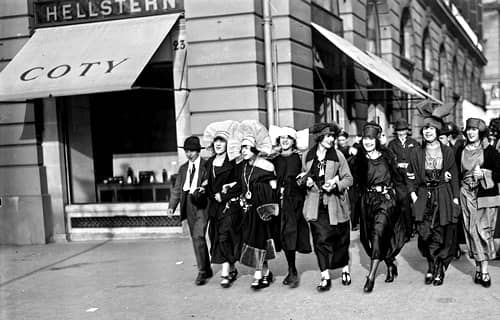
Above: 1922 Catherinettes passing by the Coty shop at 23 Place Vendôme, Paris. The Hellstern sign belongs to Hellstern & Sons, an upmarket shoe manufacturer founded in Paris in 1870.
As money poured in, Coty used it to hire salesmen – he had seven selling his products in France by 1907 (Jones, 2010. p. 31) – and to exert greater control over all aspects of the manufacturing of Coty products. This involved vertically integrating the entire production process, including packaging, and to accomplish this Coty began to buy or lease sites around Paris and establish factories on them. The main factory would be at Suresnes-sur-Seine situated just outside of the Bois de Boulogne, an industrial park later known as ‘La Cité des Parfums’.
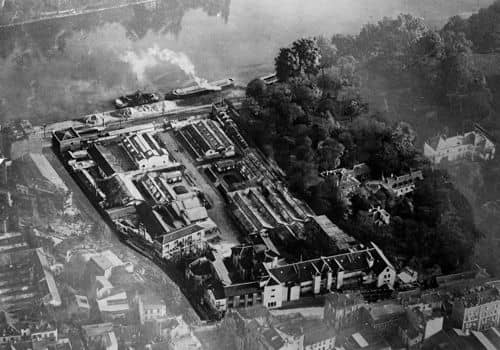
Above: 1927 ‘La Cité des Parfums’ at Suresnes-sur-Seine.
The Suresnes site made and packaged perfumes and cosmetics and housed research laboratories and the company offices. Other Coty factories included glass-blowing works at Pantin and Les Lilas; a box and coffret factory at Neuilly-sur-Seine; and a metal and glass finishing plant at Île de Puteaux. Collectively these factories ensured that by the middle of the 1920s Coty had control over most aspects of the production and packaging of its products.
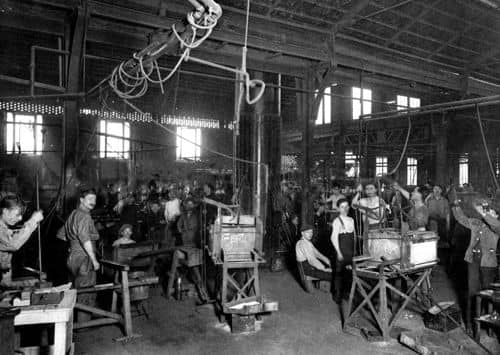
Above: French Coty Factory: Men making glass flacons (MHUSS).
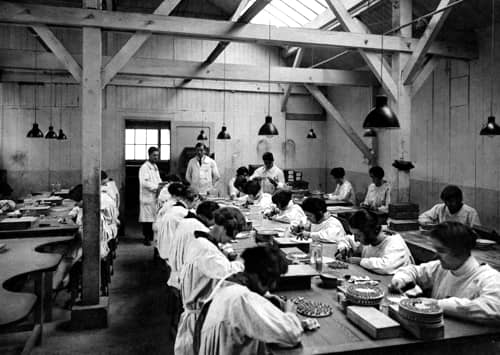
Above: French Coty Factory: Women enamelling red cases (MHUSS).
Global expansion
Coty perfumes were exported from France very early on. He was quick to recognise the importance of the American market and, by 1905, his perfumes were being imported into the United States . By 1910, Coty subsidiaries had been established in Moscow, London and New York.
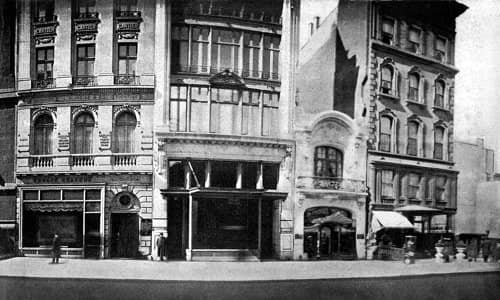
Above: 1911 Coty Building at 714 Fifth Avenue, New York (second from left). Rebuilt by the architect Woodruff Leeming [1870-1919] in 1907, the building incorporated French design details, which may have appealed to Coty who leased it in 1910. Another inducement may have been that Cartier had opened next door. Coty occupied the third floor and subleased the first two floors and the top floor to various tenants. By 1912, the windows on the third floor had been replaced with a set designed and constructed by René Lalique.
By 1912, retail businesses had been opened at 714 Fifth Avenue, New York; 20 Cheapside, London; and 33 Djamagoroff Passage, Moscow.
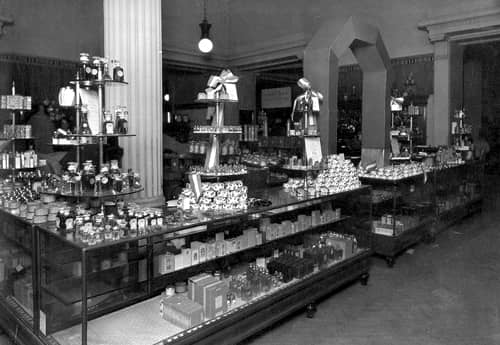
Above: c.1912 Coty counter at Selfridges, London.
Additional agencies were also founded in Buenos Aires, Rio de Janeiro, Madrid, St. Petersburg and Johannesburg. The Russian business, along with funds Coty had in Russian banks, would be confiscated by the Soviet government established during the 1917 Russian Revolution, making François Coty a lifelong enemy of communism.
1920s
During the 1920s seperate companies were established in the United States and England. Coty, Inc. was formed in New York in 1922 with laboratories and an assembly plant established at 423 West 55th Street, New York. Having the perfumes made in New York with American alcohol reduced the duties levied on them and kept their prices competitive.
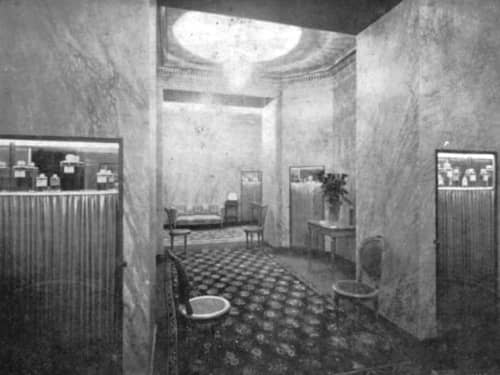
Above: 1924 Coty display at the French Exposition at the Grand Central Palace, New York.
In 1925, the American arm of Coty became a public company with Benjamin E. Levy [1878-1952] – who had been the sole agent for Coty in the United States since 1910 – as its head.
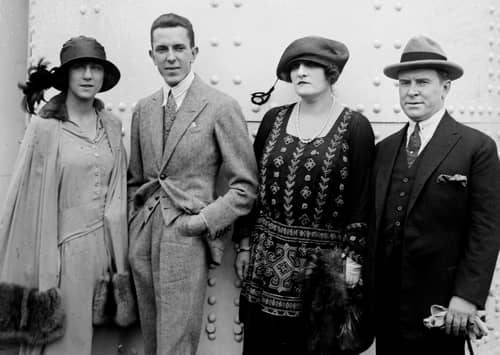
Above: c.1922 Coty group arriving in the United States. Left to right: Christiane Coty [1904-2005], Paul Dubonnet [1900-1961] – the couple were married in 1920 but divorced in 1929 – Yvonne le Baron and François Coty.
Coty (England) Ltd. was created in 1923 with showrooms opened in Walmar House at 298 Regent Street, London in 1924. C. C. Valli was made its managing director and the company operated in England, Scotland, Ireland and Wales distributing products manufactured by Coty S.A. in France.
Other notable business developments in the 1920s included: the establishment of Les Cultures Florales Méditerranéennes in 1925 to grow jasmine in the vicinity of Cannes and orange blossom flowers near Naples; the acquisition of the business, trademarks, name and formulas of the Société Française des Parfums Rallet in 1926; the organisation of the Rallet Corporation of America in 1927 to introduce and promote Rallet products in the United States; the creation of Coty S.A.R. (Societate Anonimă Română) in 1927 to serve the Balkan states; the purchase of the worldwide interests of Marie Earle in 1928; and the acquisition of Marcel Franck, a French maker of atomisers, in 1928.
See also: Marie Earle
By 1929, Coty was making a wide variety of perfumes, cosmetics and toiletries along with a range of compacts. The product list included: perfumes and eau de colognes; face, talcum, sachet, dusting and liquid powders; toilette and shaving soaps; bath salts; brilliantines and hair lotions; liquid and powder rouges; vanishing and cold creams; and hand lotions.
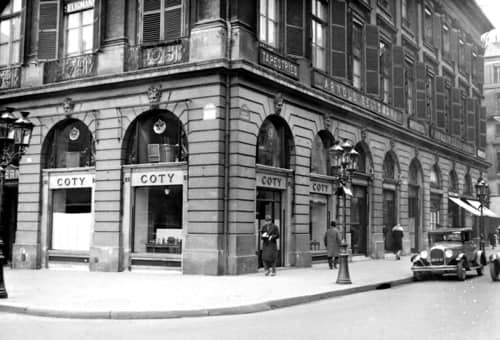
Above: 1929 Coty shop at 23 Place Vendôme, Paris.
Make-up
Like other manufacturers of perfumes, Coty added perfumes to powders which were then packaged into sachets. However, creating a face powder – a poudre de riz – required more care and expertise than producing a perfumed powder.
Face Powders: Exactly when Coty began to make face powders is unknown to me but, if an American advertisement is to be believed, it may have been as early as 1905. If so, it would not have been packaged in the box designed by Léon Bakst as he did not arrive in Paris until 1909 at the earliest. Face powders would go on to become a bigger money earner for the company than its perfumes.

Above: Coty Powder Box. The original powder box was made of Moroccan leather with gold leaf embossing from a design created by Léon Bakst [1866-1924]. Bakst’s design was the basis for a cheaper cardboard version developed by Georges Draeger [1869-1945].
By 1921, Coty Face Powders were available in a range of fragrances including: L’Origan, La Rose Jacqueminot, Chypre, Jasmin de Corse, Lilas Pourpre, Styx, L’Or, Muguet, Le Vertige, Lilas Blanc, Ambre Antique, L’Effleurt, and La Violet Pourpre. The shade range consisted of Blanc, Naturelle, Rachel No. 1, Rachel No. 2, Mauresque, Rosée No. 1, Rosée No. 2, and Mauve. Coty Face Powders also came in a compact form although this seems to have been just a smaller version of the larger face powder packed in a smaller box with a puff.
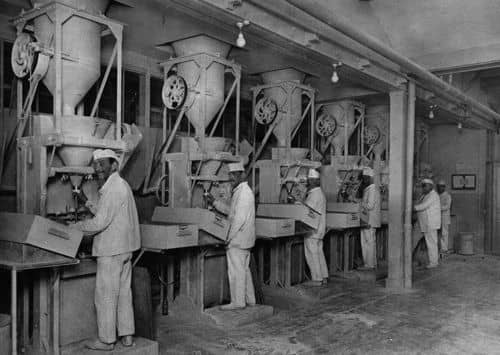
Above: French Coty Factory: Filling Face Powder boxes (MHUSS).
By 1924, Coty was making metal compacts containing compressed face powders called Poudre Compacte in the same range of shades as the loose powder forms. They were also scented in a range of perfumes including: Chypre, La Rose Jacqueminot, L’Origan, Jasmin de Corse, Styx, Paris and Emeraude.
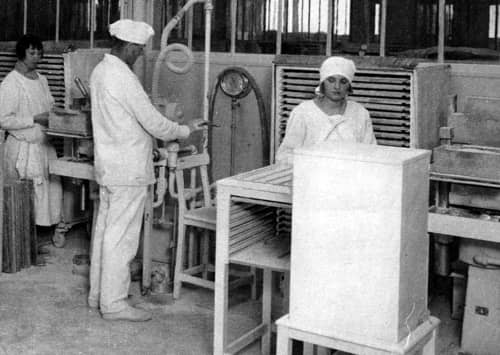
Above: French Coty Factory: Making compact powders (MHUSS).
Other make-up developments during the 1920s included the addition of liquid and compact rouges and a range of lipsticks.
Lipsticks: By the end of the decade Coty was making four distinct types of lipsticks: Original; Olympic, double the size of the standard; Gitane, a rectangular push-up automatic type; and Indelible. Like Coty powders, these were available in a range of fragrances; Olympic, for example could be bought perfumed in Chypre, L’ Origan, Paris or Emeraude. Added to this was the Tandem, which had a lipstick at one end and a perfume dropper at the other.

Above: Coty Tandem combination lipstick (Cerise) and perfume dropper. It came in a leather case. Shades: Dark (Black Band), Medium (Blue Band), Cerise (Green Band), Light (Red Band) and Invisible (White Band).
For women who preferred to apply a cream to their lips, Coty also made a lip pomade that came in a small circular metal container. I imagine that women could also use this as a cream rouge on their cheeks.
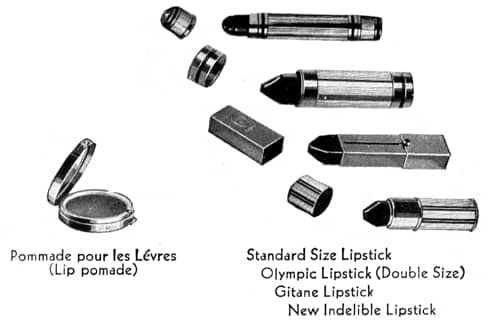
Above: c.1929 Coty Lipsticks and Lip Pomade. Olympic lipsticks came in gilt cases with differently coloured enamel bands for easy identification. Shades: Dark (Black Band), Medium (Blue Band), Cerise (Green Band), Light (Red Band) and Invisible (White Band).
Also see the company booklet: Revealing Beauty (1927)
Although there were some similarities, shade names varied from country to country.

Above: 1925 Coty lipstick shades available in France with coloured identification bands. Rose Pale (White Band), Invisible (Red Band), Cerise (Green Band), Électrique (Black Band) and Capucine (Blue Band)
As was the case with many other cosmetic companies of the time, shade ranges for Coty make-up lines were fairly limited. By 1929, in the United States, Coty rouge came in Bright, Light, Medium, Dark and Invisible; Coty lipsticks in Light, Medium, Dark, Cerise and Invisible; and Coty powders in Blanc, Naturel, Rachel No. 1, Rachel No. 2, Ocre, Ocre-Rose, Rose No. 1, Rose No. 2, Mauve and Cotytan. The Cotytan shade was introduced when Coty developed Cotytan Liquid Powder. Designed for blondes or brunettes it was to be used an alternative to developing a suntan.
It is better and lovelier than exposing your skin to blistering rays. In a few moments it gives you a glorious coat of tan—on arms, legs, face and back—and it comes off when you want to be fair again. Apply Cotytan Liquid on a pad of cotton first dampened with water. For the limbs and back apply with the palms of the hands. When it is dry, smooth on Cotytan Face Powder. This radiant golden colouring gives a new exotic beauty that will bring you a thrill—and others.
(The subtle art of make-up, p. 7)
Coty also produced guidelines for colour coordinating the various shades of face powder, lipstick and rouge. This was based primarily on hair colour with make-up suggestions for women with Blonde, Medium Blonde, Titian Blonde, Auburn, Medium Brunette, Brunette, and Gray Hair. However, Coty also made allowances for variations of eye and skin colour within these broad categories and even included suggestions for day and evening wear. Examples for Medium Brunettes and Brunettes shade selections are given below:
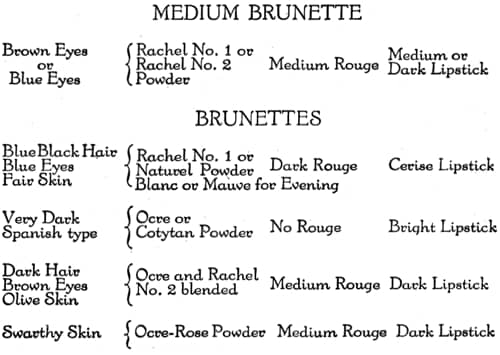
Above: c.1929 Coty shade suggestions for Medium Brunettes and Brunettes.
Also see the company booklet: The Subtle Art of Make-Up
Skin-care
Coty’s entry into skin-care began modestly in 1927 with the introduction of Colcreme Coty – a cold cream first introduced in a Lalique designed frosted glass jar with an aluminium cap – and Crème de Coty – a vanishing cream in two tones: Blanc and Rose.
Colcreme Coty: “to give youth and beauty to the skin – created at the express demand of thousands of American women, especially for the American complexion”.
Crème de Coty: “If you would see how exquisite your complexion really can be – smooth and freshen it first with COTY Vanishing Cream”.
Adding these skin-care products was a logical extension to Coty’s much larger make-up range. Colcreme Coty worked to cleanse the skin of dirt and make-up while Crème de Coty – which came in a range of Coty fragrances – provided a foundation for Coty Face Powders.
Following a repackaging of both of these products in 1928, Coty extended its skin-care range in 1929 to include skin tonics with allowances made for normal, oil and dry skins. Despite being advertised as a ‘new beauty method’ these ‘Culturiste Creations’ were not innovative and followed practices developed by Beauty Culture a decade or so earlier.
Colcreme Cleansing Cream: “Liquefying readily, penetrating deeply, cleanses the pores thoroughly of dust, cosmetics and excess oil—which do not yield to water alone”.
Potonique (Skin Tonic) Toning Lotion: “to be used instead of water. Removes all traces of cream. (Always use with cleansing cream.) Cleanses, clarifies and stimulates pores to normal activity, refining texture of the skin”.
Tissue Cream: “A rich nourishing cream for building up the underlying tissues. Corrects intense lines—rounds out thin faces and hollows and imparts velvety smoothness”.
Eau de Coty (Special Astringent): “Firms and tones loose skin and flaccid tissues without drying skin. Corrects relaxed chin and throat. Reduces puffiness around eyes”.
Lotion Pour La Peau (Skin Lotion): “The correct make-up foundation for skins inclined to be dry, or exposed to dry conditions. Soothing, healing, giving a flattering youthful bloom”.
Creème de Beauté (Foundation Cream): “The perfect, velvety make-up base for the normal or oily skin, or under humid conditions. Gives the essential protection from sun, wind and dust”.
See also: Cold Creams, Vanishing Creams and Skin Tonics, Astringents and Toners
The development of the ‘Culturiste Creations’ skin-care line may have had some assistance from Marie Earle which had a long history of developing skin-care products. Coty had acquired an interest in that company in 1926 and bought it outright in 1928.
American takeover
By 1928 net income from Coty U.S. had reached US$4.05 million as compared to earnings of US$1.64 million from the French company, Coty S.A. which meant that the sales and income from American Coty outstripped all the other branches.
In 1925, Coty U.S. became a recapitalised public-traded company. Then, in August, 1929 – one month before before the stock market crash of October 29, 1929 – it acquired a majority interest in the five European Coty companies: Coty S.A. (France), Coty (England) Ltd., Coty S.A.R. (Romania), Les Cultures Florales Méditerranéennes, and the Société Française des Parfums Rallet.
The impetus for the American buyout is unclear but the probable reason was money. François Coty was short of cash. Both of his French newspapers ‘Le Figaro’ (acquired 1922) and ‘Le Gaulois’ (acquired 1928) were losing money as was a third paper, ‘L’Ami du Peuple’, that he had established in 1928. François had been unable to interest Crédit Lyonnais – then the largest bank in France – to invest in Coty S.A. (Jones, 2010, p. 108) so he needed another source for a cash injection.
Tax reduction may have been a second reason. François had been fighting the French Finance Ministry regarding unpaid taxes since at least 1926. Profits from Coty U.S were being diverted through Omnium de Participations Industries de Luxe S.A. (OPIL) based in Switzerland, so the buyout may have been part of a tax minimisation strategy.
François’ financial situation became more difficult in 1929 when Yvonne Dubois Le Baron divorced him. François had a long history of taking mistresses, his current being Henriette Dieudé who had five children by him. Yvonne seems to have lived with this until she became romantically involved with Léon Cotnareanu who urged her to get a divorce and marry him. Yvonne did so three months after her divorce came through. By the terms of the settlement, François was expected to pay Yvonne 425 million francs in three instalments. Unfortunately, when he defaulted on the third alimony payment, Yvonne used American courts to gain control of Coty’s American assets. By the time François Coty died in 1934, he had lost control of the perfume and cosmetics empire he had created and his newspapers.
1930s
By 1929, it seems fairly clear that Coty U.S. had plans to become more widely involved in cosmetics. A 1929 report developed for the company by Lehman Brothers spoke glowingly of the growth in cosmetics and outlined some expected product developments.
New items which the company will place on the market within a short time, and for which a substantial demand is expected, include: Skin Tonics, Skin Lotions, Liquid Dentrifices, Tissue Creams, Complete Sets of Manicure Essentials (featuring Liquid Nail Polish) individually and in gift boxes, Colored Boxes and Metal Cases for Perfumes, New Designs of Lipstick Containers and Rouge Compacts, and a complete line of Men’s Toilette Articles, including Shaving Cream, Talcum, Toilette Water, Hair Tonic, etc.
Many of these articles, especially the perfumes, are presented in bottles of fine cut glass, leather boxes and metal containers for gift purposes. Attractive sets containing various combinations of perfumes and toilette articles are also featured.
All Coty products have been consistently large sellers. Last year over 13,500,000 boxes of powders were sold in the United States. Perfumes and toilette waters totalled 4,261,927 bottles.(Lehman Brothers, 1929, p. 5)
Although the stock market crashed in 1929, Coty went ahead with two of these product developments and in 1930 introduced complete sets of Manicure Essentials – including a perfumed Liquid Nail Polish – and a complete line of men’s toiletries.
Nail polish: Items in the range could be bought individually or in one of three sets each packaged in a Bakelite dressing table tray. Products in the range included: Liquid Polish (Shades: Clear, Medium, Deep), Liquid Polish Solvent, a Nail Brush, Cuticle Cream, Cuticle Remover, a Steel File, Emery Boards, a tube with Sterilised Cotton and an Orange Stick.
Men’s line: In late 1920s, Coty was selling a limited range of products specifically aimed at men – Shaving Soap, Talcum Powder, Astringent, Toilet Soap and Hair Lotion – all perfumed with Eau de Coty. The American arm of Coty repackaged these in 1930 and sold them individually or in three different combination sets in navy-blue boxes.

Above: 1930 Coty Men’s Toiletries repackaged for the American market.
As the depression deepened, Coty embraced some radial changes. In the United States, this meant introducing measures to counter the dramatic fall in sales, one of which was to reduce prices and widen the number of sales outlets. In hindsight this has generally been regarded as a mistake as it cheapened the brand. In 1934, the American company seems to have taken steps to partially rectify this. It stopped using wholesalers and confined its merchandise to sales agents and retailers on a consignment basis (Bader & Picker, 1947, p. 132). It also ceased sales to outlets that did not promote and sell Coty products in accordance with the company’s instructions or discounted prices set by Coty.
Company advertising in the United States was also updated and, by 1930, the Lalique designed header that had been prominent in a lot of Coty advertising there had disappeared. The relationship between Coty and Lalique had ceased by 1934, by which time Coty had updated most of its cosmetic packaging with cheaper, more contemporary designs. These underwent further redesigns during the decade.
Britain went off the gold standard in 1931 and imposed import duties on cosmetics and toiletries in 1931 and 1932. This prompted the establishment of a new British company, Coty Manufacturing Co. Ltd., in 1932 and the development of manufacturing facilities in Brentford, Middlesex.
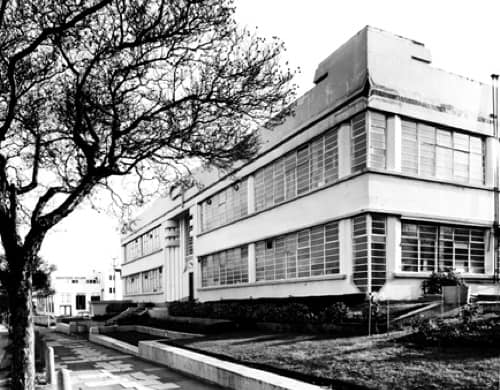
Above: Coty Manufacturing Co. Ltd. plant at Brentford, Middlesex designed by Wallis, Gilbert & Partners, a company founded in 1916 by Thomas Wallis [1872-1953].
The manufacturing company would be amalgamated with Coty (England) Ltd. in 1936.
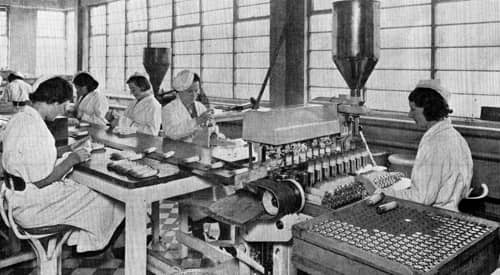
Above: 1937 Manufacturing tubes of Coty Shaving Cream by Coty (England) Ltd. at Brentford.
Like Coty companies elsewhere Coty England dropped its prices but then raised the cost of many items in 1933. In 1934, it also opened a new showroom at 2 New Bond Street, London in New Bond Street House. The building was the headquarters of F. W. Woolworths & Co. Ltd. until 1959.
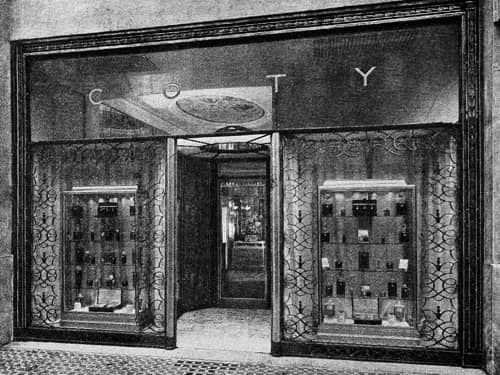
Above: 1934 New Coty Showroom at 2 Bond Street, London. The front of the shop was decorated with French wrought iron. Inside can be seen a ceiling design painted by the Parisian artist Paul Vera [1882-1957].
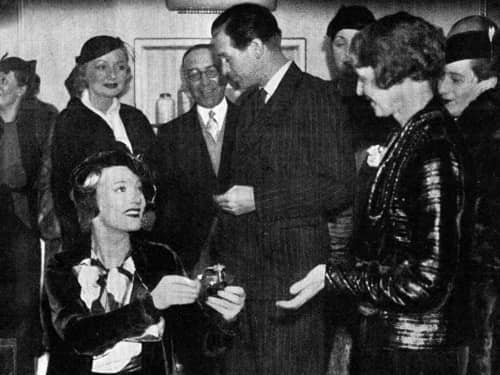
Above: 1934 Gertrude Laurence spraying perfume after she had opened the new Coty showroom. Next to her is Douglas Fairbanks Jnr. She broke a bottle of perfume to repeat the mythical stunt Coty was said to have used to promote La Rose Jacqueminot in 1903. Standing behind Douglas Fairbanks is Mr C. C. Valli, the managing director of Coty (England) Ltd.
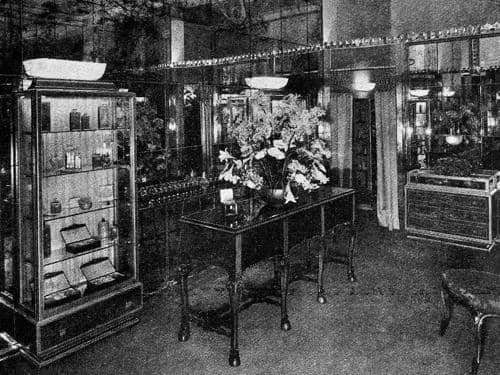
Above: 1934 Interior of the new Coty Showroom at 2 Bond Street, London.
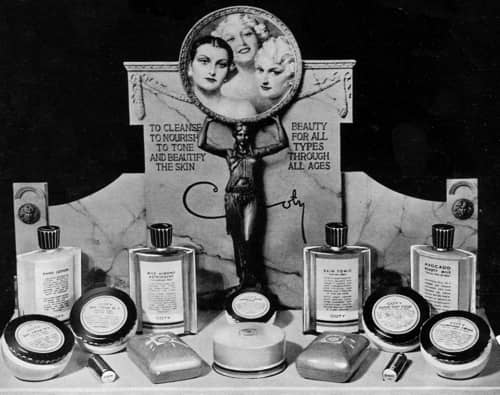
Above: 1936 Coty products sold in Britain.
As the depression deepened many countries increased import duties to protect local industries. This may have been part of the reason behind Coty establishing new companies around the world in the 1930s including: Coty S.A. (Argentina), Coty S.A.B. (Brazil), Coty S.A.I. (Italy), and Coty S.A.M. (Mexico).

Above: 1938 Coty S.A.I. (Italy).
Coty also modernised its manufacturing facilities in France completing the building upgrade at Suresnes-sur-Seine by 1936 at the latest.
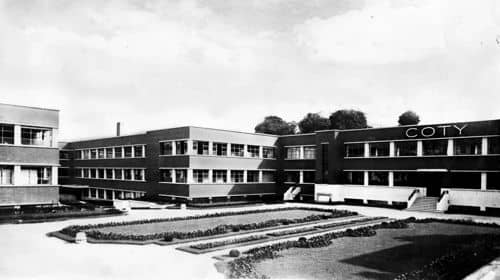
Above: Modernised factory at Suresnes-sur-Seine. designed by Jean Barot [1900-1967] in red brick, concrete and glass. The new buildings contained manufacturing facilities as well as laboratories and administration offices.

Above: Another view of the factory at Suresnes-sur-Seine. Although modified it still stands today
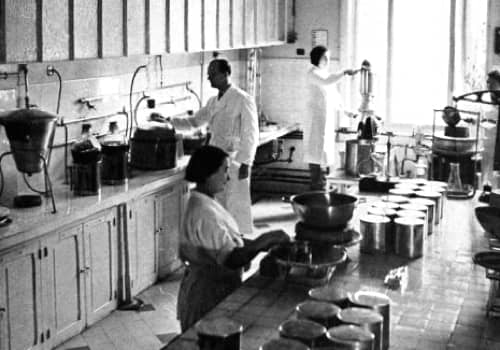
Above: 1938 Weighing ingredients for Coty creams at Suresnes.

Above: 1938 Mixing Coty creams at Suresnes.
Skin-care
A number of changes were made to Coty’s skin-care and make-up ranges during the decade. In 1931, Coty introduced a Liquefying Cleansing Cream for dry, normal and slightly oily skin types and the company followed this with a range of skin products based on function including a Tissue Cream and Eye Cream.
Liquefying Cleansing Cream: “Quick-melting, penetrating, it really removes obstinate soil, and make-up, giving fresh beauty”.
Tissue Cream: “To nourish the skin … rich and exquisitely scented, very effective in discouraging lines and wrinkles—from sun or years”.
Eye Cream:“Will correct those tired lines about your eyes and nourish the tissue”.
See also: Liquefying Cleansing Creams
When added to previously existing skin tonics and astringents these products could be combined into standard beauty routines and in 1931 the American company began selling Beauty Kits for normal and dry skins, later also called Beauty Guardian Kits. The normal or slightly oily skin kit contained Liquefying Cleansing Cream, Tissue Cream, Foundation Cream, Skin Tonic and cleansing tissues. The dry skin kit contained Liquefying Cleansing Cream, Tissue Cream, Skin Tonic, Skin Lotion and cleansing tissues.
In 1936, Coty also introduced Avocado Beauty Milk and Avocado Beauty soap into its beauty regime using Calvalo (Californian) avocado oil; the first major cosmetic company to do so. An Avocado Shaving Stick (1938) would be the first of many avocado lines Coty would add later.
See also: Avocado Oil and the company booklet: The Secret of Coty Avocado Preparations
Coty skin-care lines were not the same the world over. For example, in Europe and Great Britain, Day Creams (Crème de Jour) were featured, with Day Cream No 1 used for oily skin and Day Cream No. 2 for dry. European countries and Great Britain also sold a Wrinkle Cream (Crème Antirides) but I have not found a similarly named product in the United States.
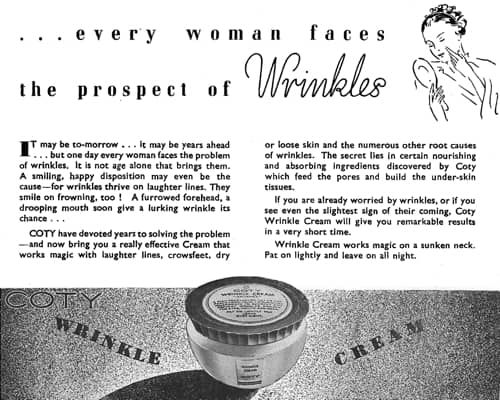
Above: Coty Crème Antirides (Wrinkle Cream). Bowl shaped cream pots were used across Europe and Great Britain but do not appear to have been employed in the United States.
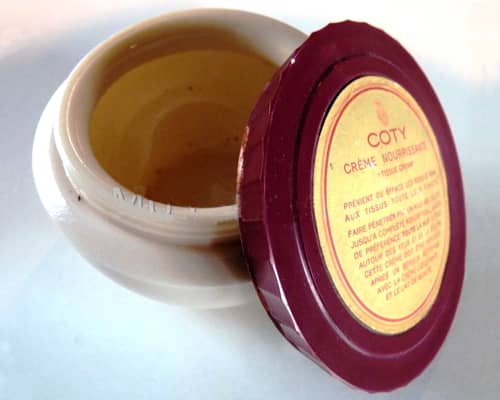
Above: Coty Crème Nourrissante (Nourishing Cream) (MHUSS).
In Europe and Great Britain there is also evidence of a specific night treatment regime consisting of Liquefying Cleansing Cream, Beauty Milk and Nourishing Cream. Although I have not found one, it seems likely that Skin Lotion and Tissue Cream could have been used in a night treatment regime in the United States.
Make-up
One has the feeling that face powders and lipstick were more important to U.S. Coty’s bottom line than its skin-care range and the company made numerous changes to its lipsticks and face powders during the decade to maintain their competitiveness.
Lipsticks: In 1931, in the United States, Coty had an indelible lipstick on the market in three shades (Light, Medium and Dark) priced at US$1.00 or US$1.50 depending on the case.
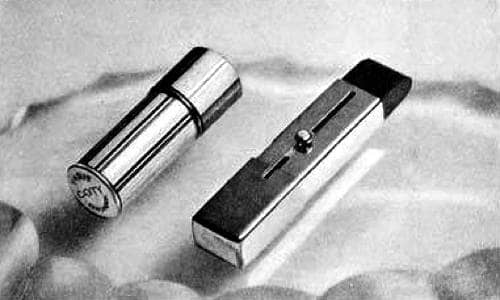
Above: 1931 Coty Indelible and Gitane Lipsticks. The later came in platinum and gilt casings.
In 1932, in the face of declining sales, Coty U.S. introduced a cheaper indelible in five shades (Extra Light, Bright, Light, Medium and Dark) priced at US50 or 55 cents depending on the outlet. This new lipstick was housed in a simpler, cylindrical, gilt brass (Rubens) container with a button slide of black enamel using a design developed in France.
In 1934, a higher-priced (Continentale) case – with the Coty logo on its side – was added, selling at US$1.10 followed by a smaller, cheaper embossed (Sub-Deb) case. Both lipsticks were later advertised as containing eight drops of ‘Essence of Theobroma’ – possibly cocoa butter – which was said to reduced the drying effect often associated with early indelibles. The price of the Sub-Deb was dropped to 50 cents at the end of 1935 and was followed by a larger sized version in a ‘Periscope’ case later in the decade. Coty also got a more imaginative when naming its lipstick shades which by 1939 included Light, Bright, Medium, Dahlia, Gitane (Gypsy) and Magnet Red.
As with skin-care, there were differences in the Coty case designs, case names and shade names around the world. For example Sub-Deb lipstick cases appear to have been restricted to the United States.
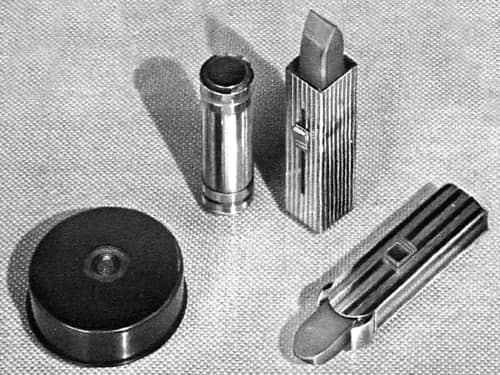
Above: Coty rouge (left) and three Coty lipsticks. These European lipsticks were named (left to right) Olympic, Crik and Grand Lux available in five shades: Invisible (Light), Vif (Bright), Moyen (Medium), Capucine (Orange) and Foncé (Dark). Coty patented the opening mechanism used in the Grand Lux case.
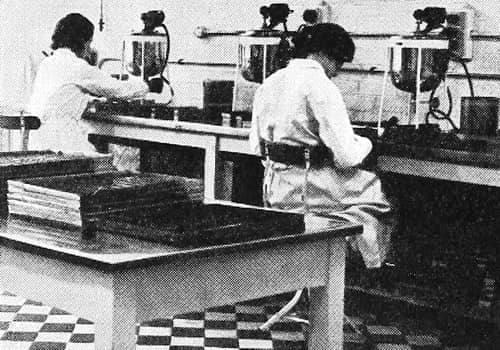
Above: 1939 Pouring lipsticks into moulds at the British Coty factory in Brentford, Middlesex.
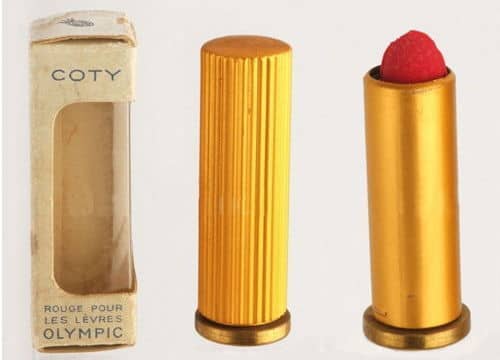
Above: Rouge pour les Lèvres Olympic (MHUSS).
Also see the company booklets: Le chemin de la Beauté and De nieuwe weg naar Schoonheid
Powder: By 1934, Coty was selling over 60 million boxes of face powder worldwide, making it the biggest money earner for the company. Unfortunately, in the American market, Coty was losing out to Lady Esther who had become the largest selling face powder there largely on the back of a clever advertising campaign. Based around the ‘bite test’ Lady Esther suggested that most other face powders on the market were gritty.
See also: The Bite Test
In 1934, Coty repackaged its face powders scented with Paris, L’Aimant or Emeraude fragrances keeping the ‘powder puff’ box for face powders scented with L’Origan, Chypre, Styx and other perfumes. Then, in 1935, looking for a way to improve the fineness of their face powders – and so pass the ‘bite test’ – Coty secured the exclusive rights to a brand of air-powered micronisers and began marketing their face powders as ‘Air Spun’.
See also: Coty “Air Spun” Powder
The new powder was a great success and doubled Coty sales in many parts of the world after it was introduced. Coty was so impressed with the results that it installed a working air-powered microniser into its pavilion display at the 1939 New York World’s Fair, enabling visitors to see it in operation.
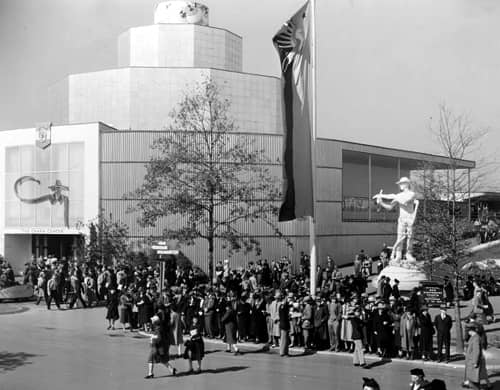
Above: 1939 Coty pavilion at the New York World’s Fair.
See also: Coty and the 1939 New York World’s Fair
By 1936, Air Spun Face Powder was being made in two textures, ‘Original’ for normal skins and ‘Special’ for dry skins. Both types of powder were available in a wide variety of Coty fragrances. Coty also put the Air Spun powder into a new larger box with a plastic base and a full-sized window. The powder came in twelve shades including Naturel, Rachel No. 1, Rachel No 2, Rose No. 1, Rose No. 2, Ocre, Soleil d’Or, Perle Rose, Rachel Nacré and Gitane to which, in 1937, Coty added MiBlonde and Brunat shades for blondes and brunettes respectively.
Air Spun powder could be held on with Foundation Cream or Skin Lotion but in 1938 Coty introduced a Foundation Lotion in two shades: Natural, for fair skin; and Gitane, for brunette skins or as a base for suntan make-up. The Gitane shade of Foundation Lotion, along with products such as Cotytan and Coty Suntan Lotion, helped Coty cater for those women who followed the suntanning craze that started in the 1920.
Rouge: By 1936, Coty had added a Cream Rouge to its range in shades that included: Moyen, Capucine, Fonce, Vif, Invisible and Saturne. Then, in 1937, Coty began selling its compressed rouge as Air Spun in shades that harmonised with their Air Spun Face Powders.
Eyeshadow: Another addition to the Coty make-up range in the 1930s was a cream eyeshadow in both plain and pearly shades. However, as far as I can tell Coty eye make-up did not include mascara.
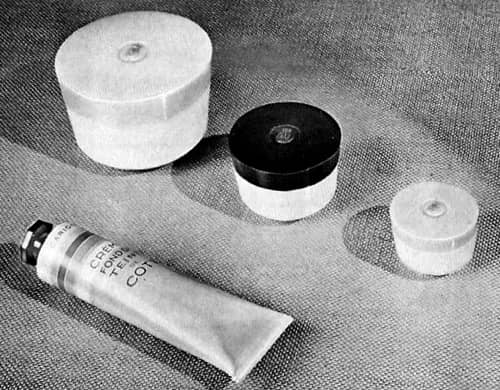
Above: c.1936 Coty cream make-up. Left to right: Fond de Teint (Foundation) in Cristal Rosé, Banane, Ottomane, Perle Rosée, Antilles, and Carioca shades; Fard Onctueux (Cream Rouge) in Tzigane, Andalouse, Hawaïenne, Napolitaine, Provençale, Mauresque, Parisienne, and Sultane; and Fards Pour Paupières (Eyeshadow) in Gris, Gris Bleu, Bleu Azur, Vert Jade, Diaphane, Sépia and Marron. A tube of Fond de Teint (Foundation) is at the front.
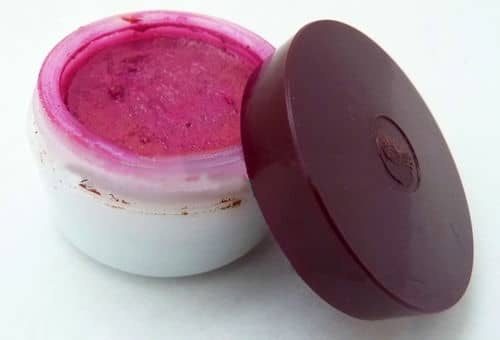
Above: Coty Fard Onctueux (Cream Rouge) (MHUSS).
Reorganisation
By the end of 1939, Coty’s financial situation in the United States had improved. Over four million people had visited the Coty Pavilion at the New York World’s Fair and domestic sales for Coty U.S. had reached US$6.6 million, generating a net profit of US$937,610; its best year for the 1930s and a significant improvement over the loss the company experienced in 1935. Coty U.S. was still the largest earner with Coty S.A. (France) second with sales of US$1.7 million.
In 1939, a decision was taken to organise the parts of Coty into two new corporations, both registered in Delaware. In July, 1939, a new Coty Inc. was created to control the American assets and Coty International, Inc. was established to look after the foreign companies including: Omnium de Participations Industries de Luxe SA (Switzerland); Compagnie International de Parfumerie (Monaco); Coty (England) Ltd.; Coty S.A. (France); CA et L.S.A. (France); Société Française des Parfums Rallet S.A. (France); Societe Independante d’Achats S.A. (France); Les Cultures Florales Méditerranéennes S.A. (France); Société Française des Cartonnages de Luxe S.A. (France); Coty S.A.R. (Romania); Coty S.A.I. (Italy); Coty S.A.M. (Mexico); Coty S.A.A. (Argentina); and Coty S.A.B. (Brazil). Each shareholder in the old Coty Inc. (U.S.) – which directly or indirectly controlled all the other parts of Coty – received one share in the new Coty Inc. and one in Coty International. Although separate, the two Delaware corporations had interlocking directorships.
Late in 1940, by which time France had fallen to the Germans, some adjustments to this arrangement were made. Two new Panama corporations were created: Omnium de Participations Industries de Luxe S.A. (Panama) and Bema Corporation S.A. (Panama). These new companies acquired the three Latin American subsidiaries – until then owned by the Swiss and Monaco parts of Coty – along with a substantial proportion of Coty (England) Ltd. and Coty S.A. (France). This protected the Latin-American subsidiaries from the Nazis and also reduced foreign taxes paid on dividends.
Timeline
| 1900 | Coty enters the perfume trade at the time of his marriage to Yvonne Le Baron. |
| 1904 | Coty S.A. founded in Paris. New Products: La Rose Jacqueminot perfume. |
| 1906 | Shop opened at 23 Place Vendôme, Paris Coty products first sold in the United States. |
| 1908 | Business centre moves to Suresnes-sur-Seine. |
| 1910 | London and Moscow subsidiaries established. |
| 1912 | American branch opened on 714 Fifth Avenue, New York. |
| 1922 | Coty, Inc. formed in New York. Laboratories and assembling plant established at 423 West 55th Street, New York. |
| 1923 | Coty (England) Ltd. created. |
| 1924 | London showrooms opened in Walmar House at 298 Regent Street. |
| 1925 | Coty, Inc. (U.S.) becomes a publicly traded company. Les Cultures Florales Méditerranéennes established. |
| 1926 | Coty buys an interest in Marie Earle. Coty acquires Société Française des Parfums Rallet. |
| 1927 | Rallet Corporation of America organised. London showrooms of Coty moved to 3 Stratford Place. Coty, Societate Anonima Romana created. New Products: Colcreme Coty; and Crème de Coty. |
| 1928 | Coty buys Marie Earle. |
| 1929 | Coty, Inc. (U.S.) acquires Coty S.A. (France), Coty (England) Ltd., Coty S.A.I. (Italy), Coty S.A.R. (Romania), Coty S.A.B. (Brazil), Coty S.A.M. (Mexico), Les Cultures Florales Mediterranéennes and Société Française des Parfums Rallet. New Products: Cotytan Liquid Powder; Potonique (Skin Tonic) Toning Lotion; Eau de Coty (Special Astringent); Tissue Cream; and Crème de Beauté. |
| 1930 | Coty begins radio advertising (U.S.). Men’s line repackaged. New Products: Manicure Kits; and Perfumed Manicure Polish. |
| 1931 | New Products: Liquefying Cleansing Cream. |
| 1932 | Coty Manufacturing Co. Ltd. established (U.K.). New Products: Indelible Lipstick. |
| 1935 | New Products: Air Spun Face Powder. |
| 1936 | Coty Manufacturing Co. Ltd. amalgamates with Coty (England), Ltd. New Products: Avocado Beauty Milk; and Avocado Beauty Soap. |
| 1937 | New Products: Air Spun Rouge. |
| 1938 | New Products: Foundation Lotion; and Avocado Shaving Stick. |
| 1939 | Coty split into a U.S. based company and Coty International. Coty takes over the rotunda in the Cosmetics Building at the New York World’s Fair. |
| 1940 | Omnium de Participations Industries de Luxe S.A. (Panama) and Bema Corporation S.A. (Panama) created. |
Continue to: Coty (post-1940)
First Posted: 23rd August 2016
Last Update: 5th February 2024
Sources
Bader, L., & Picker, S. (1947). Marketing drugs and cosmetic. New York: D. Van Nostrand company, Inc.
Bron, L. (1938). Le parfum Français. La Parfumerie Modern. No. 12, December, 517, 520-521, 523.
Coty. (n.d.). The subtle art of make-up [Booklet]. New York: Author.
Coty. (n.d.). Le chemin de la beauté [Booklet]. France: Author.
Coty. (n.d.). The secret of Coty avocado preparations [Booklet]. United Kingdom: Author.
Coty, Inc. Annual Reports 1939-1940.
Coty International Corporation. Annual Reports 1939-1940.
de Sarran, P. (1990). François Coty, empereur d’Artigny: La parfum de la Gloire. Tours: Éditions de la Nouvelle République.
Jones, G. (2010). Beauty imagined: A history of the global beauty industry. Oxford: Oxford University Press.
Healy, O. (2004). Coty: The brand of visionary. New York: Assouline.
Lehman Brothers. (1929). Coty, Inc. A history and analysis of this company and its recently-acquired foreign affiliates. New York: Author.
Musée d’Histoire Urbaine et Sociale de Suresnes [MHUSS]. (2016). Retrieved August 12, 2016 from http://webmuseo.com/ws/musee-suresnes/app/report/index.html
Toledano, R. B., & Coty, E. Z. (2009). François Coty: Fragrance, power money. Gretana: Pelican Publishing Company.
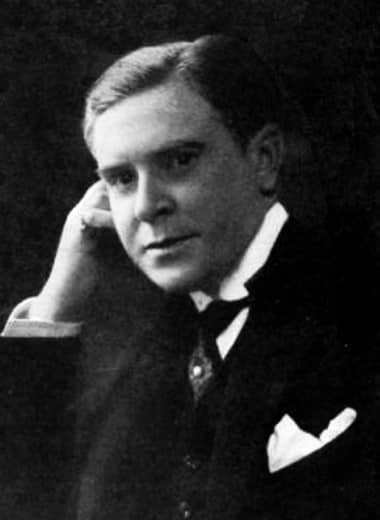
François Coty (born Joseph Marie François Spoturno) [1874-1934]. Described as blonde, with green eyes, medium face, big mouth, round chin, and one metre 65 centimetres tall.
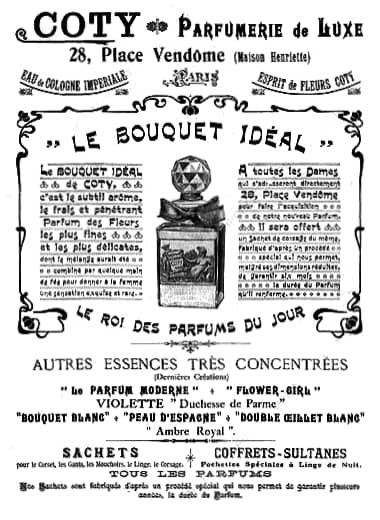
1902 Coty Le Bouquet Idéal.
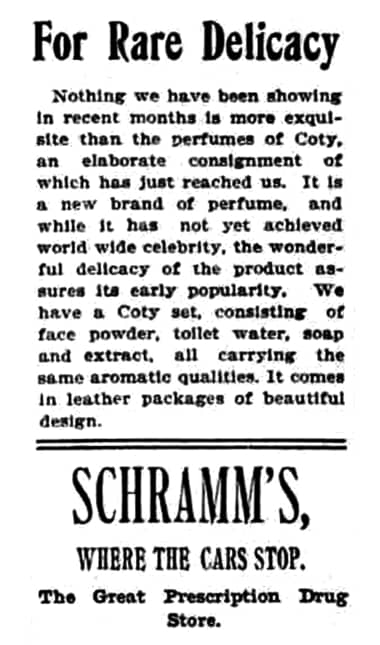
1905 Coty products being sold through Schramm’s Drug Store in Salt Lake city.

1913 Les Parfums de Coty.
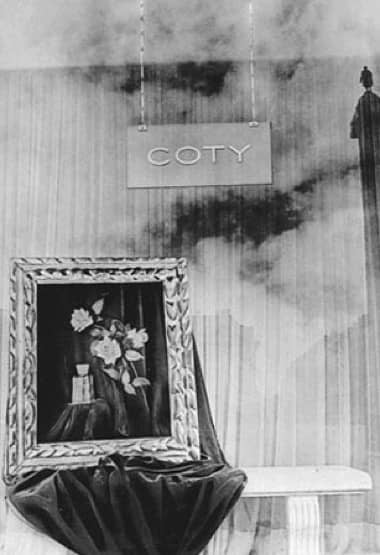
Coty store widow at 23 Place Vendôme, Paris with the Place Vendôme Column reflected in the glass.
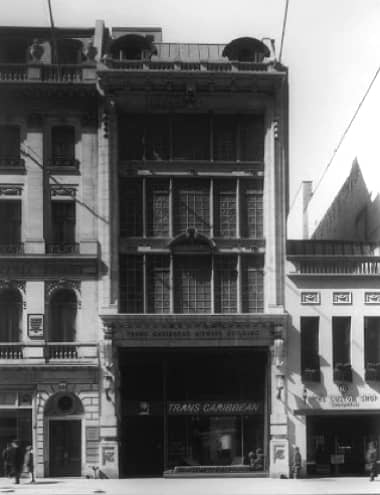
Coty Building at 714 Fifth Avenue, New York (center) with the René Lalique glass windows installed covering the whole of the third floor. These saved the building from demolition in the 1980s and it still stands today.
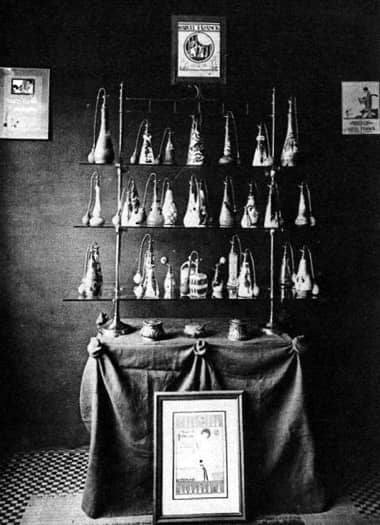
1920 Display of Marcel Franck atomisers at a French trade show. Coty bought the company in 1928.
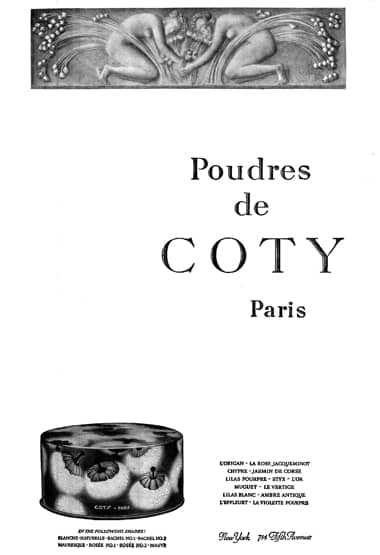
1921 Coty Face Powder.
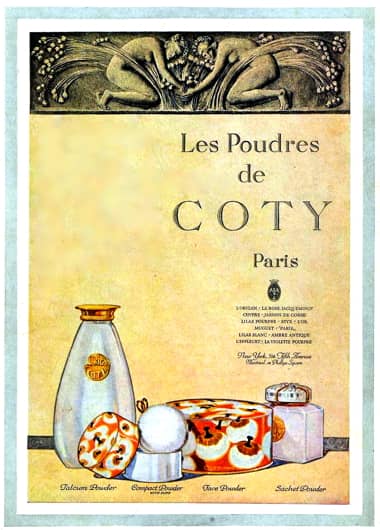
1922 Coty Talcum, Compact, Face and Sachet Powders.
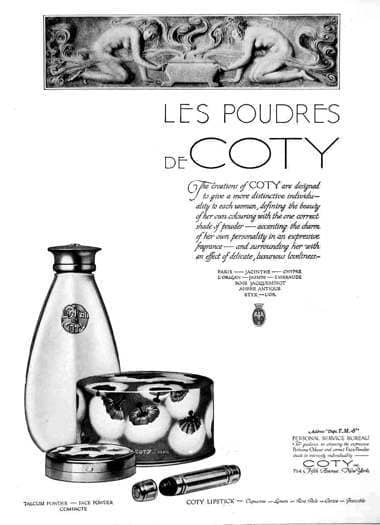
1923 Coty Talcum, Compacte and Face Powder, and Coty Lipstick.
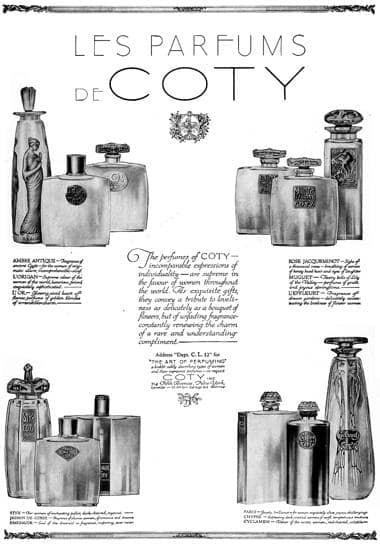
1923 Les Parfums de Coty.
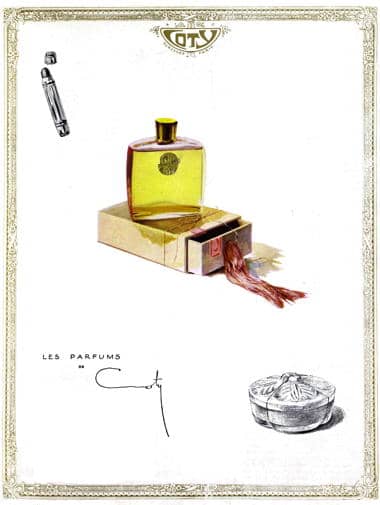
1924 Les Parfums de Coty.
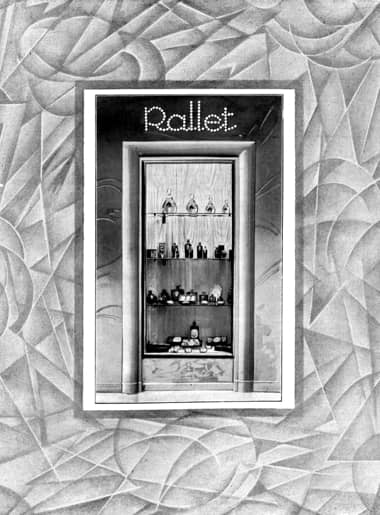
1925 Société Française des Parfums Rallet. Coty acquired Rallet in 1926 and then organised the Rallet Corporation of America in 1927 to promote Rallet perfumes there. Coty also used Marie Earle outlets to sell Rallet perfumes.
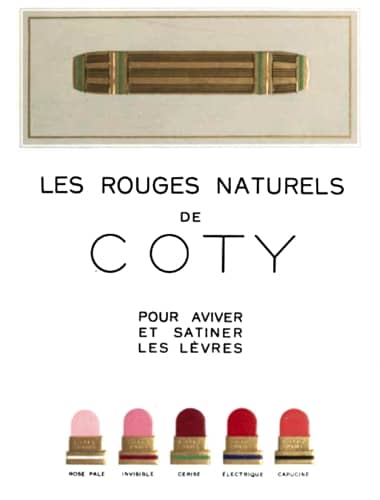
1925 Coty lipstick.
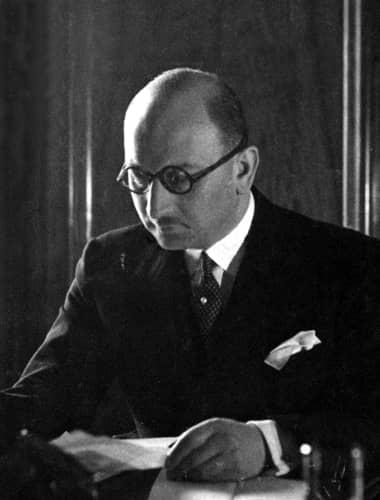
Raymond Charles Greilsamer [1889-1970]. After working for Coty in Germany he moved to France in 1932 – presumably to escape Jewish persecution — and was placed in charge of the Suresnes-sur-Seine site. He escaped the Nazi occupation of France, became a director of Coty Inc. and Coty International, before becoming vice-president of the later organisation (MHUSS).

1926 Coty Poudre Compacte and refill.
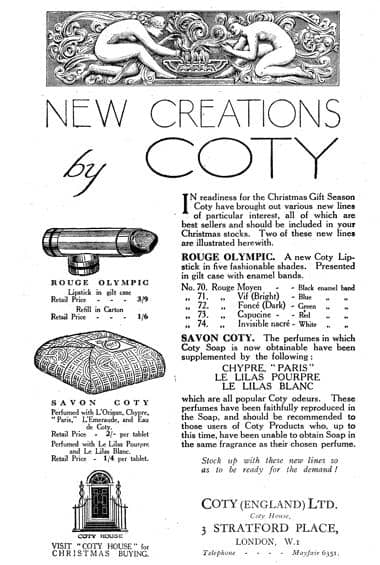
1927 British trade advertisement for Coty products.
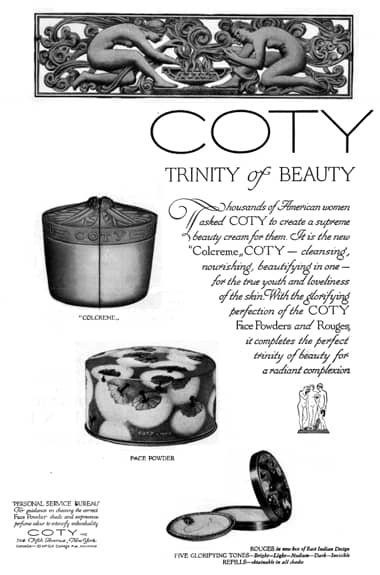
1928 Coty Colcreme, Face Powder and Rouge.

1928 German advertisement announcing Coty has sold over 10 million bottles of perfume and 33 million boxes of powder.
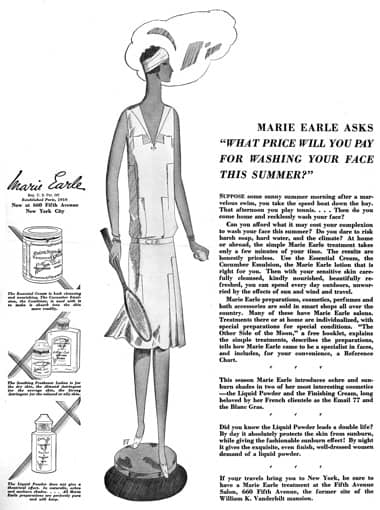
1928 Marie Earle. After buying an interest in the company in 1926, Coty went on to purchase it outright in 1928.
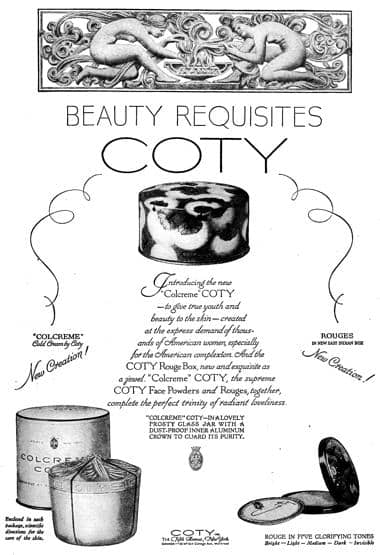
1928 Coty Beauty Requisites: Face Powder, Colcreme and Rouge.
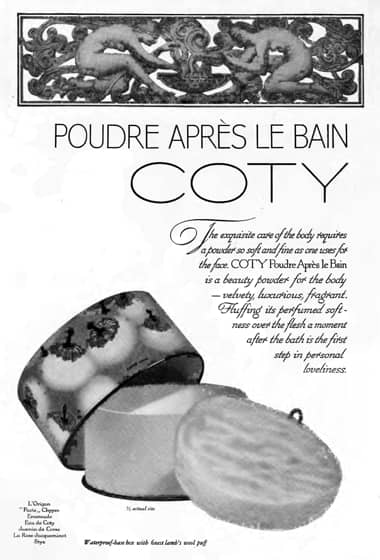
1928 Coty Poudre Apres le Bain. It came in a range of fragrances including Chypre, La Rose Jacqueminot, L’Origan, Jasmin de Corse, Styx, Paris, Emeraude and Eau de Coty.
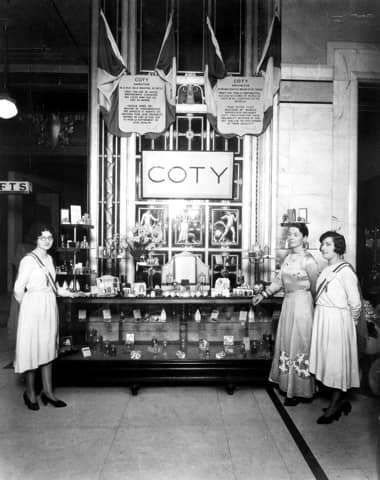
1929 Coty counter at Selfridges department store, London.
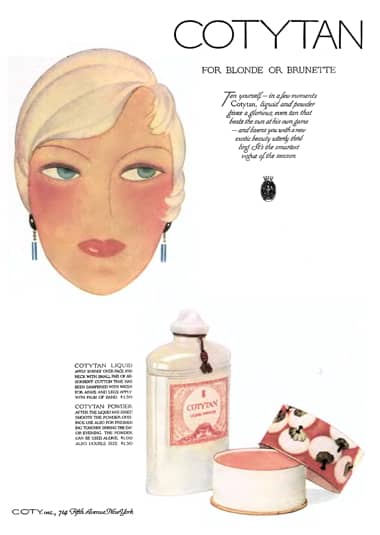
1929 Cotytan.
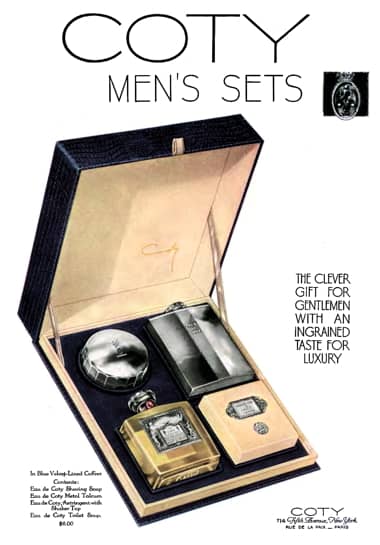
1929 Coty Men’s Toiletries.
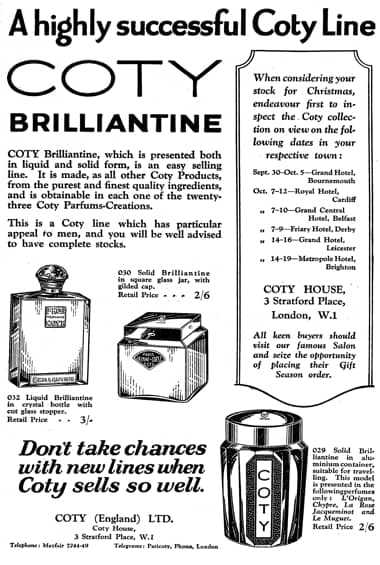
1929 British trade advertisement for liquid and solid Coty Brilliantines.
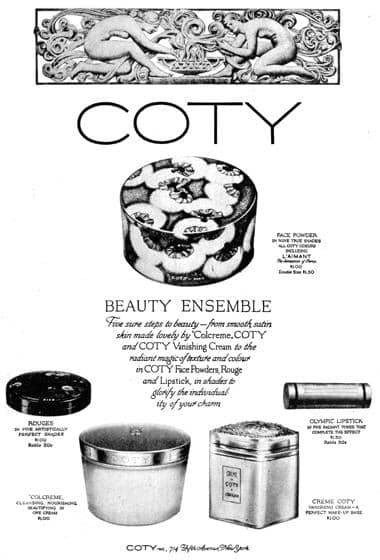
1929 Coty Rouge, Colcreme, Creme Coty and Olympic Lipstick.

1929 British trade advertisement for Coty Gitane Lipsticks.
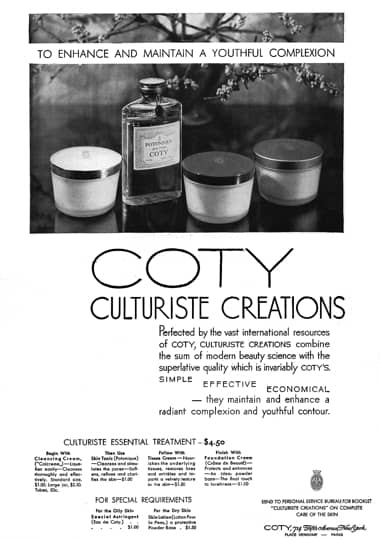
1930 Coty Culturiste Creations.
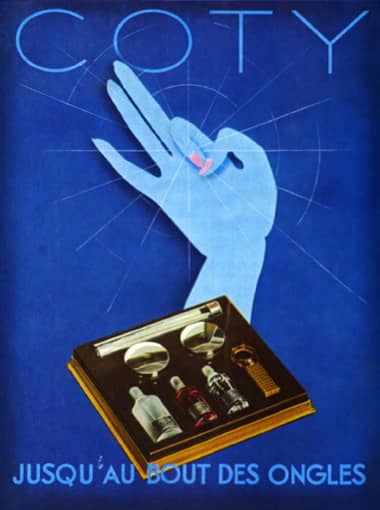
1930 Coty Manicure Cosmetics.
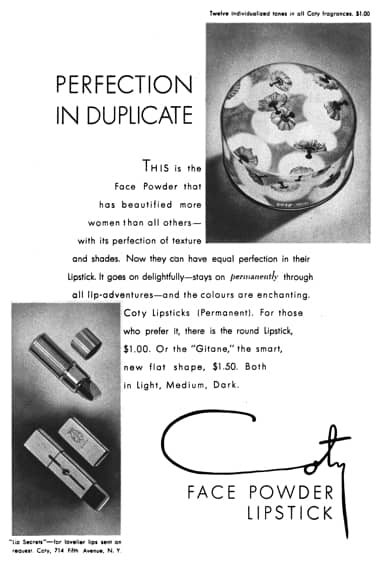
1931 Coty Face Powder and Lipsticks.
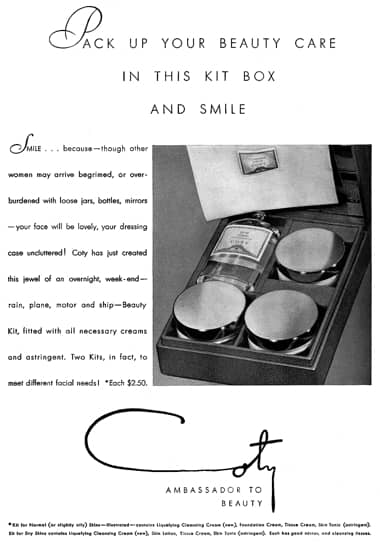
1931 Coty Beauty Kit, handsomely boxed with a large mirror. The kit came in two forms, one for normal skin and one for dry.
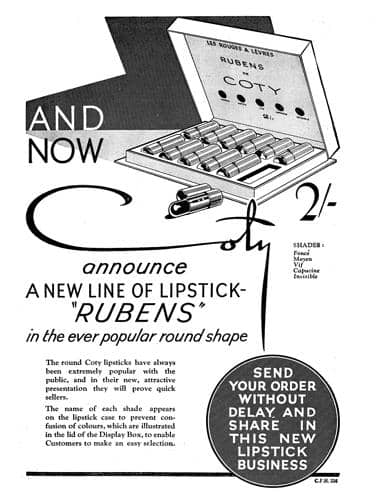
1932 British trade advertisement for Coty Rubens Lipsticks.
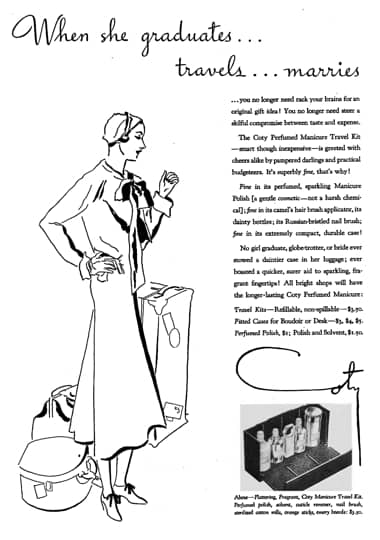
1932 Coty Perfumed Manicure Travel Kit.
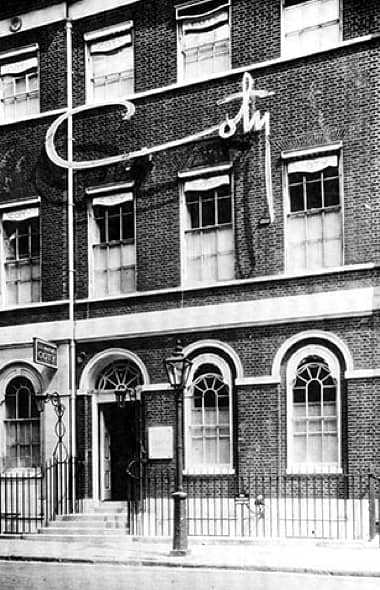
Coty House at 3 Stratford Place, London. Coty moved the company’s London showrooms to this Adam style building in 1927.
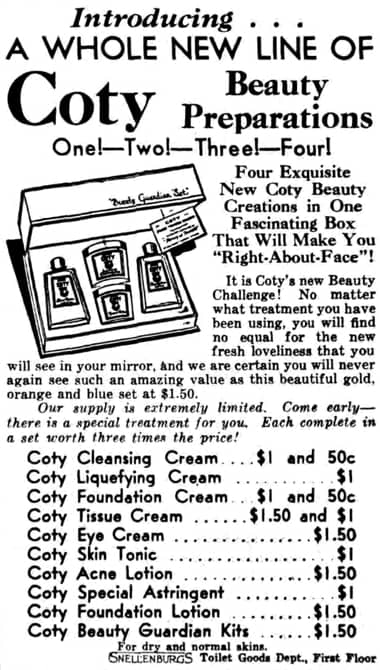
1933 Coty American beauty products.
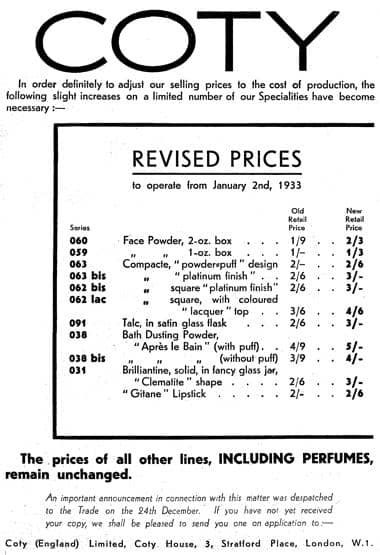
1933 Notification of price rises by Coty (England) Ltd.
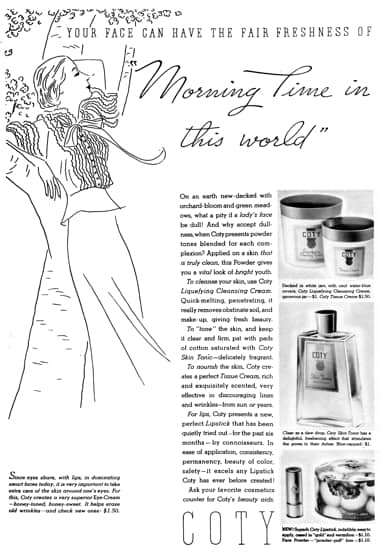
1934 Coty Liquefying Cleansing Cream, Tissue Cream, Skin Tonic, Indelible Lipstick and Face Powder.
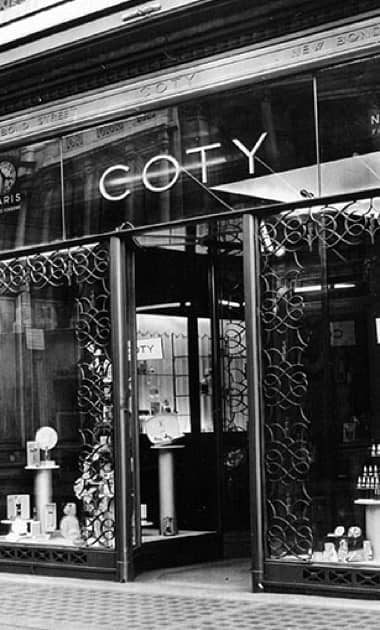
Coty at 2 New Bond Street, London. A number of changes have been made to the exterior of the building since it was first opened in 1934.
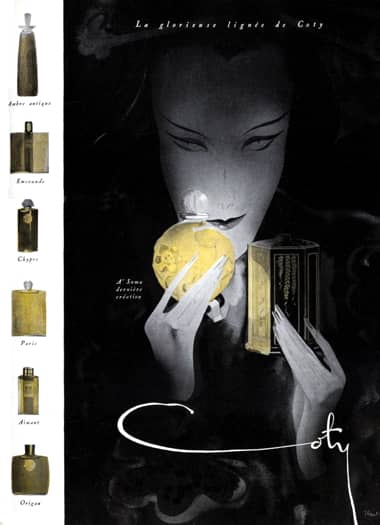
1934 Coty Perfumes.
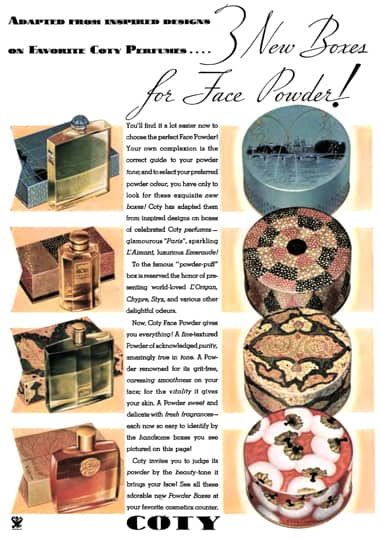
1934 Coty Paris, L’Aimant and Emeraude fragranced powder boxes in new packaging to match perfumes. Emeraude was repackaged in 1938 in a Persian green container.
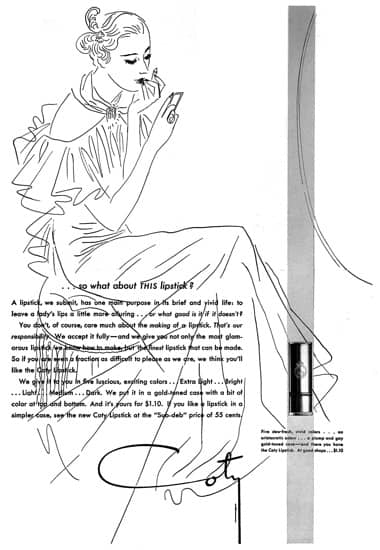
1935 Coty Sub Deb Lipstick.
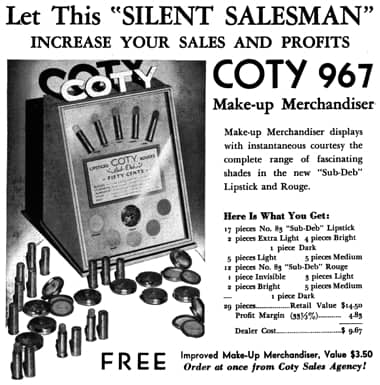
1935 Coty 967 Make-up Merchandiser to sell Sub Deb lipstick and rouge (United States).
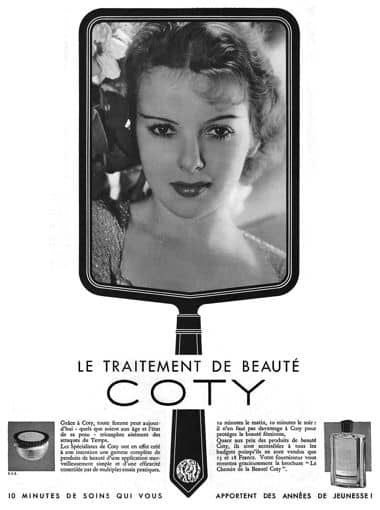
1936 Coty Le Traitement de Beauté.
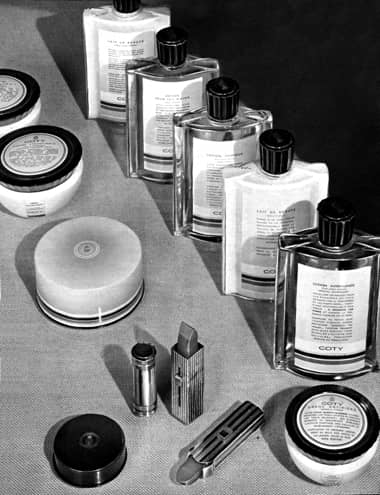
1936 Coty French beauty products.

c.1937 Coty United Kingdom beauty products. The products sold in Britain are similar to those sold in the rest of Europe but differs in many ways to those sold in the United States. For example, both France and Britain sold two Day Creams – Day Cream No. 1 for dry skin, Day Cream No. 2 for oily skin &ndash but, as far as I can tell, these creams were not available in America.
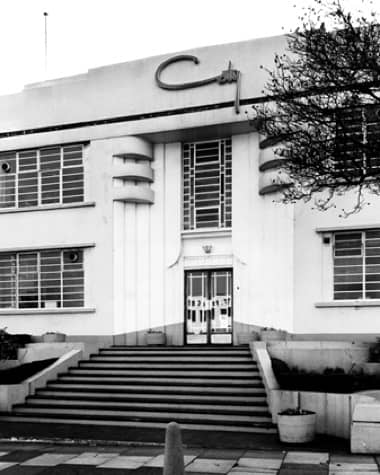
1937 Entrance to the British Coty factory at Brentford, Middlesex.
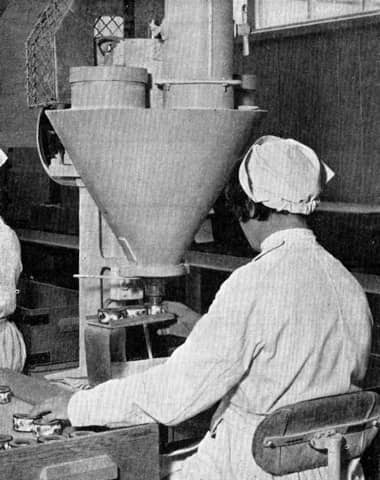
1937 Filling Air Spun Face Powder boxes at the British manufacturing facilities in Brentford, Middlesex.
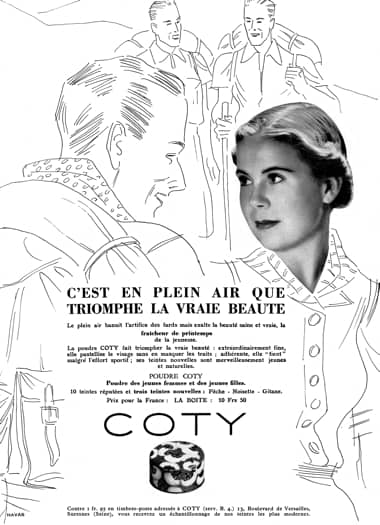
1938 Poudre Coty in 10 shades. New shades: Pèche, Noisette and Gitane.
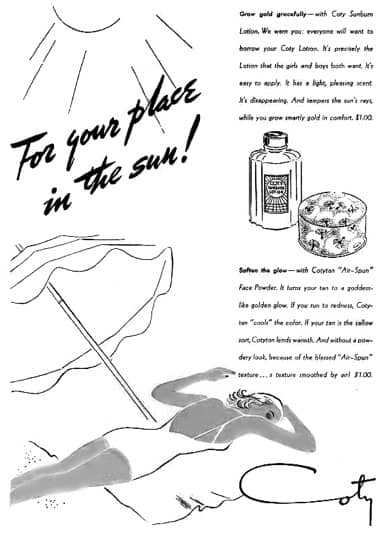
1938 Coty Sunburn lotion and Coty Air Spun Powder in Cotytan shade.
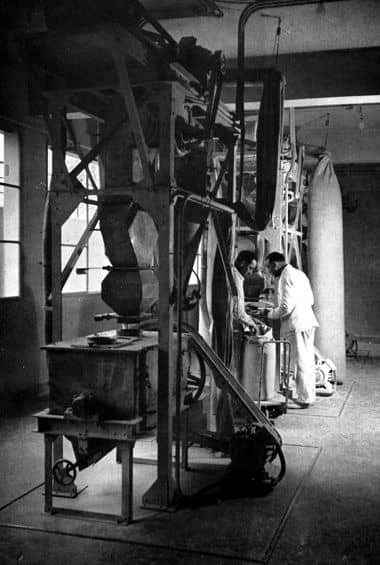
1938 Sifting Coty face powders at Surneses-sur-Seine.
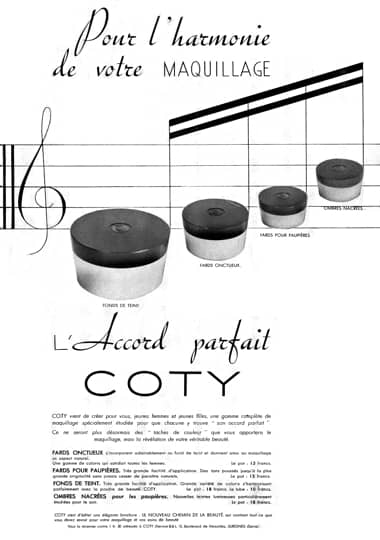
1938 Coty French make-up. Left to right: Fonds de Teint (Foundations), Fards Onctueux (Cream Rouge), Fards Pour Paupières (Eyeshadows) and Ombres Nacées (Pearly Eyeshadows).

1939 Coty Air Spun Face Powder.

1939 Coty Avocado Beauty Milk.
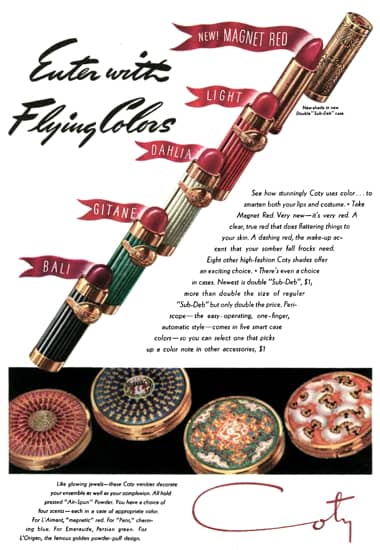
1939 Coty Sub-Deb lipsticks in standard and double-sized ‘Periscope’ cases and Coty Pressed Air Spun Powder cases: L’Aimant (red), Paris (blue), Emeraude (Persian green), and L’Origan (powder puff)
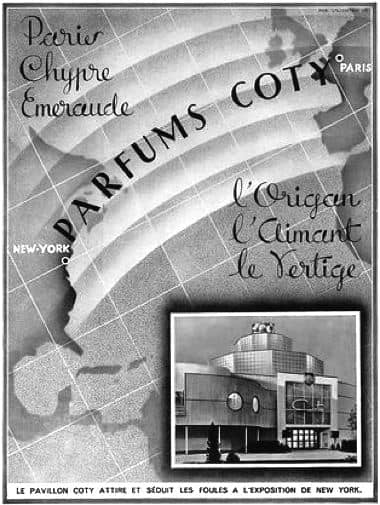
1939 Parfums Coty and the New York World’s Fair.
